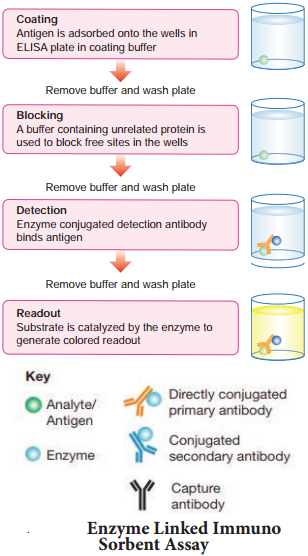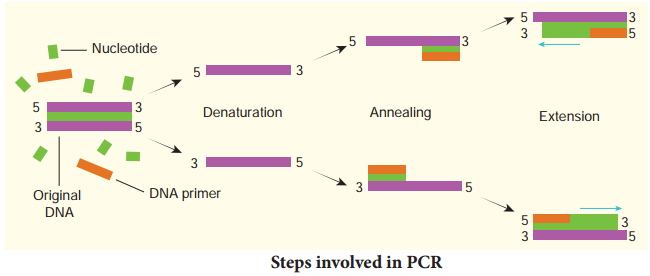Learninsta presents the core concepts of Biology with high-quality research papers and topical review articles.
Molecular Diagnostics
Early diagnosis of infectious diseases or inherent genetic defects is essential for appropriate treatment. Early detection of the disease is not possible using conventional diagnostic methods like microscopic examinations, serum analysis and urine analysis. These laboratory techniques are indirect and not always specific. Scientists are continuously searching for specific, sensitive and simple diagnostic techniques for diagnosis of diseases.
Recombinant DNA technology, Polymerase Chain Reactions (PCR) and Enzyme Linked Immunosorbent Assay (ELISA) are some of the techniques that are reliable and help in early diagnosis. Presence of pathogens like virus, bacteria, etc., is detected only when the pathogen produces symptoms in the patient. By the time the symptoms appear concentration of pathogen becomes very high in the body. However very low concentration of a bacteria or a virus, even when the symptoms of the disease does not appear, can be detected by amplification of their nucleic acid.
ELISA [Enzyme Linked Immunosorbent Assay]
ELISA is a biochemical procedure discovered by Eva Engvall and Peter Perlmanin (1971) to detect the presence of specific antibodies or antigens in a sample of serum, urine, etc., It is a very important diagnostic tool to determine if a person is HIV positive or negative.
ELISA is a tool for determining serum antibody concentrations (such as the antibodies produced in a person infected by pathogens such as HIV) and also for detecting the presence of specific antigens and hormones such as human chorionic gonadotropins.
During diagnosis the sample suspected to contain the antigen is immobilized on the surface of an ELISA plate (Fig. 9.5). The antibody specific to this antigen is added and allowed to react with the immobilized antigen. The anti-antibody is linked to an appropriate enzyme like peroxidase.
The unreacted anti-antbody is washed away and the substrate of the enzyme (hydrogen peroxidase) is added with certain reagents such as 4-chloronaphthol. The activity of the enzyme yields a coloured product indicating the presence of the antigen. The intensity of the colour is directly proportional to the amount of the antigen. ELISA is highly sensitive and can detect antigens in the range of a nanogram.

There are four kinds of ELISA namely, Direct ELISA, Indirect ELISA, sandwich ELISA and competitive ELISA. It is a highly sensitive and specific method used for diagnosis. ELISA possesses the added advantages of not requiring radioisotopes or a radiation counting apparatus. PCR (Polymerase Chain Reaction) The polymerase chain reaction (PCR) is an invitro amplification technique used for synthesising multiple identical copies (billions) of DNA of interest. The technique was developed by Kary Mullis (Nobel laureate, 1993) in the year 1983.
Denaturation, renaturation or primer annealing and synthesis or primer extension, are the three steps involved in PCR (Fig. 9.6). The double stranded DNA of interest is denatured to separate into two individual strands by high temperature .
This is called denaturation. Each strand is allowed to hybridize with a primer (renaturation or primer annealing). The primer template is used to synthesize DNA by using Taq – DNA polymerase.

During denaturation the reaction mixture is heated to 95° C for a short time to denature the target DNA into single strands that will act as a template for DNA synthesis. Annealing is done by rapid cooling of the mixture, allowing the primers to bind to the sequences on each of the two strands flanking the target DNA. During primer extension or synthesis the temperature of the mixture is increased to 75° C for a sufficient
period of time to allow Taq DNA polymerase to extend each primer by copying the single stranded template.
At the end of incubation both single template strands will be made partially double stranded. The new strand of each double stranded DNA extends to a variable distance downstream. These steps are repeated again and again to generate multiple forms of the desired DNA. This process is also called DNA amplification.
The PCR technique can also be used for amplifications of RNA in which case it is referred to as reverse transcription PCR (RT-PCR). In this process the RNA molecules (mRNA) must be converted to complementary DNA by the enzyme reverse transcriptase. The CDNA then serves as the template for PCR.
PCR In Clinical Diagnosis
The specificity and sensitivity of PCR is useful for the diagnosis of inherited disorders (genetic diseases), viral diseases, bacterial diseases, etc., The diagnosis and treatment of a particular disease often requires identifying a particular pathogen. Traditional methods of identification involve culturing these organisms from clinical specimens and performing metabolic and other tests to identify them.
The concept behind PCR based diagnosis of infectious diseases is simple – if the pathogen is present in a clinical specimen its DNA will be present.
Its DNA has unique sequences that can be detected by PCR, often using the clinical specimen (for example, blood, stool, spinal fluid, or sputum) in the PCR mixture. PCR is also employed in the prenatal diagnosis of inherited diseases by using chorionic villi samples or cells from amniocentesis. Diseases like sickle cell anemia, β-thalassemia and phenylketonuria can be detected by PCR in these samples.
CDNA from PCR is a valuable tool for diagnosis and monitoring retroviral infections e.g., Tuberculosis by Mycobacterium tuberculosis. Several virally induced cancers, like cervical cancer caused by Papilloma virus can be detected by PCR. Sex of human beings and live stocks, embryos fertilized invitro can be determined by PCR by using primers and DNA probes specific for sex chromosomes. PCR technique is also used to detect sex-linked disorders in fertilized embryos.
Applications of PCR
The differences in the genomes of two different organisms can be studied by PCR. PCR is very important in the study of evolutions, more specifically phylogenetics. As a technique which can amplify even minute quantities of DNA from any source, like hair, mummified tissues, bones or any fossilized materials.
PCR technique can also be used in the field of forensic medicine. A single molecule of DNA from blood stains, hair, semen of an individual is adequate for amplification by PCR. The amplified DNA is used to develop DNA fingerprint which is used as an important tool in forensic science. Thus, PCR is very useful for identification of criminals. PCR is also used in amplification of specific DNA segment to be used in gene therapy.